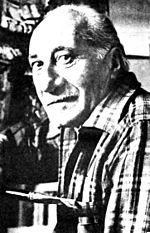Juan Carlos Castagnino facts for kids
Quick facts for kids
Juan Carlos Castagnino
|
|
|---|---|

Juan Carlos Castagnino
|
|
| Born | November 18, 1908 |
| Died | April 21, 1972 (Aged 63) Buenos Aires, Argentina
|
| Nationality | Argentine |
| Known for | Painter, architect, muralist and sketch artist |
| Awards | Grand Prize of Honor, Argentine National Hall (1961) Medal of Honor at Expo '58 (Brussels) Special mention, II Mexico City Biennale (1962) |
Juan Carlos Castagnino (born November 18, 1908 – died April 21, 1972) was a famous Argentine artist. He was a talented painter, architect, muralist (someone who paints large pictures on walls), and sketch artist.
He was born in a small village called Camet, near the city of Mar del Plata. Juan Carlos studied art at the Escuela de Bellas Artes in Buenos Aires. There, he learned from well-known artists like Lino Enea Spilimbergo and Ramón Gómez Cornet.
Contents
Early Life and Art
In the late 1920s, Juan Carlos Castagnino became part of the Communist Party of Argentina. In 1933, he joined the first group of artists in Argentina. Later that year, he showed his art at the National Fine Arts Hall in Buenos Aires.
His early paintings often showed things as they really looked. This style is called realism. Over time, his art became more focused on drawing people and objects in a recognizable way, which is called figurative art.
Castagnino believed art could show important ideas about society. Many of his works shared messages about people's lives and communities. However, he also painted many different kinds of subjects.
Murals and Travels
Juan Carlos Castagnino worked with other famous artists like Antonio Berni and Lino Enea Spilimbergo. They also worked with Mexican muralist David Alfaro Siqueiros. Together, they painted large murals for a businessman named Natalio Botana. These murals were in his home in Don Torcuato.
In 1939, Castagnino traveled to Paris, France. There, he studied at the workshop (called an atelier) of cubist painter André Lhote. Cubism is an art style where objects are broken up and put back together in different ways.
He then traveled across Europe to improve his art skills. He met and spent time with other famous artists like Georges Braque, Fernand Léger, and Pablo Picasso.
Return to Argentina and Achievements
Castagnino came back to Argentina in 1941. He went to the University of Buenos Aires and earned a degree in architecture.
He won many awards for his art in the years that followed. In 1961, he received the Grand Prize of Honor from the Argentine National Hall. He also won a Medal of Honor at Expo '58 in Brussels in 1958. In 1962, he received a special mention for his drawings at the II Mexico City Biennale. A biennale is a large art exhibition that happens every two years.
His drawings for the book Martín Fierro were very famous. This book is the national poem of Argentina, written by José Hernández. The University of Buenos Aires Press (EUDEBA) published the edition with Castagnino's illustrations.
Juan Carlos Castagnino passed away in Buenos Aires in 1972.
Legacy and Museum
The Municipal Museum of Art in his hometown of Mar del Plata was renamed in his honor in 1982. It is now called the Juan Carlos Castagnino Municipal Museum of Art. Castagnino had given over 130 of his artworks to this museum.
See also
 In Spanish: Juan Carlos Castagnino para niños
In Spanish: Juan Carlos Castagnino para niños

